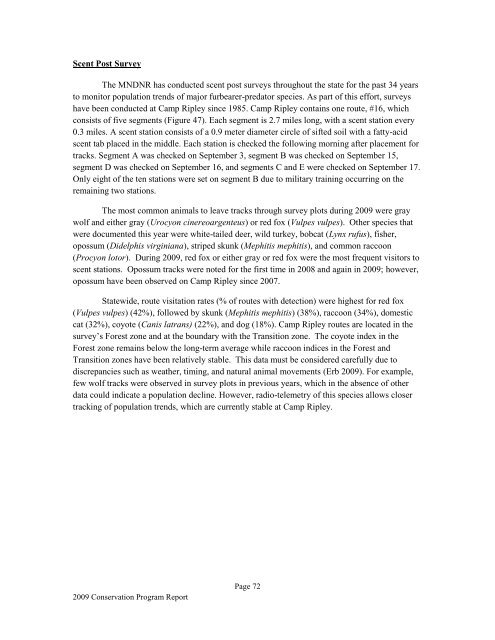camp ripley and arden hills minnesota army national guard training ...
camp ripley and arden hills minnesota army national guard training ...
camp ripley and arden hills minnesota army national guard training ...
You also want an ePaper? Increase the reach of your titles
YUMPU automatically turns print PDFs into web optimized ePapers that Google loves.
Scent Post Survey<br />
The MNDNR has conducted scent post surveys throughout the state for the past 34 years<br />
to monitor population trends of major furbearer-predator species. As part of this effort, surveys<br />
have been conducted at Camp Ripley since 1985. Camp Ripley contains one route, #16, which<br />
consists of five segments (Figure 47). Each segment is 2.7 miles long, with a scent station every<br />
0.3 miles. A scent station consists of a 0.9 meter diameter circle of sifted soil with a fatty-acid<br />
scent tab placed in the middle. Each station is checked the following morning after placement for<br />
tracks. Segment A was checked on September 3, segment B was checked on September 15,<br />
segment D was checked on September 16, <strong>and</strong> segments C <strong>and</strong> E were checked on September 17.<br />
Only eight of the ten stations were set on segment B due to military <strong>training</strong> occurring on the<br />
remaining two stations.<br />
The most common animals to leave tracks through survey plots during 2009 were gray<br />
wolf <strong>and</strong> either gray (Urocyon cinereoargenteus) or red fox (Vulpes vulpes). Other species that<br />
were documented this year were white-tailed deer, wild turkey, bobcat (Lynx rufus), fisher,<br />
opossum (Didelphis virginiana), striped skunk (Mephitis mephitis), <strong>and</strong> common raccoon<br />
(Procyon lotor). During 2009, red fox or either gray or red fox were the most frequent visitors to<br />
scent stations. Opossum tracks were noted for the first time in 2008 <strong>and</strong> again in 2009; however,<br />
opossum have been observed on Camp Ripley since 2007.<br />
Statewide, route visitation rates (% of routes with detection) were highest for red fox<br />
(Vulpes vulpes) (42%), followed by skunk (Mephitis mephitis) (38%), raccoon (34%), domestic<br />
cat (32%), coyote (Canis latrans) (22%), <strong>and</strong> dog (18%). Camp Ripley routes are located in the<br />
survey‟s Forest zone <strong>and</strong> at the boundary with the Transition zone. The coyote index in the<br />
Forest zone remains below the long-term average while raccoon indices in the Forest <strong>and</strong><br />
Transition zones have been relatively stable. This data must be considered carefully due to<br />
discrepancies such as weather, timing, <strong>and</strong> natural animal movements (Erb 2009). For example,<br />
few wolf tracks were observed in survey plots in previous years, which in the absence of other<br />
data could indicate a population decline. However, radio-telemetry of this species allows closer<br />
tracking of population trends, which are currently stable at Camp Ripley.<br />
2009 Conservation Program Report<br />
Page 72
















